人教版高一英语必修一Unit-3-语法
- 格式:ppt
- 大小:736.50 KB
- 文档页数:20
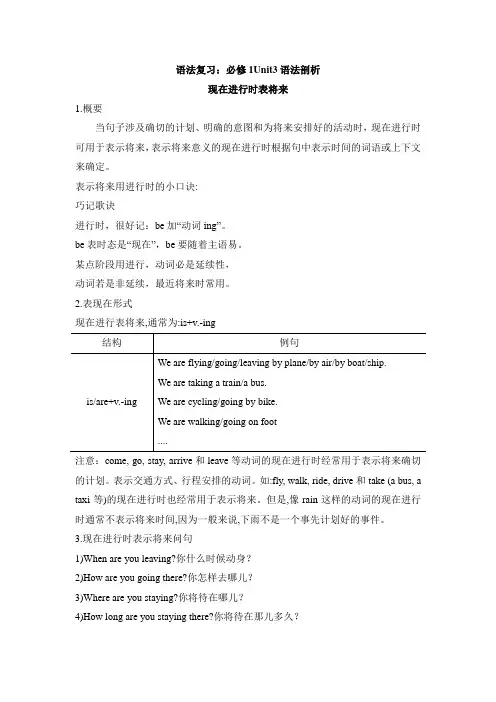
语法复习:必修1Unit3语法剖析现在进行时表将来1.概要当句子涉及确切的计划、明确的意图和为将来安排好的活动时,现在进行时可用于表示将来,表示将来意义的现在进行时根据句中表示时间的词语或上下文来确定。
表示将来用进行时的小口诀:巧记歌诀进行时,很好记:be加“动词ing”。
be表时态是“现在”,be要随着主语易。
某点阶段用进行,动词必是延续性,动词若是非延续,最近将来时常用。
2.表现在形式现在进行表将来,通常为:is+v.-ing注意:come, go, stay, arrive和leave等动词的现在进行时经常用于表示将来确切的计划。
表示交通方式、行程安排的动词。
如:fly, walk, ride, drive和take (a bus, a taxi等)的现在进行时也经常用于表示将来。
但是,像rain这样的动词的现在进行时通常不表示将来时间,因为一般来说,下雨不是一个事先计划好的事件。
3.现在进行时表示将来问句1)When are you leaving?你什么时候动身?2)How are you going there?你怎样去哪儿?3)Where are you staying?你将待在哪儿?4)How long are you staying there?你将待在那儿多久?5)When are you coming back?你啥时候回来?【活学活用】13.用动词的适当形式填空1)You _______ (stay) with us this weekend.2)We _______ (leave) soon, Mr Lee.3)She thinks he _______ (die).4)They _______ (go) to Shanghai this Friday.5)Tom _______ (come) here next week.6) The train_______ (arrive) in three hours.答案:1)are staying 2)are leaving 3)is dying 4)are going 5)is coming 6) is arriving。
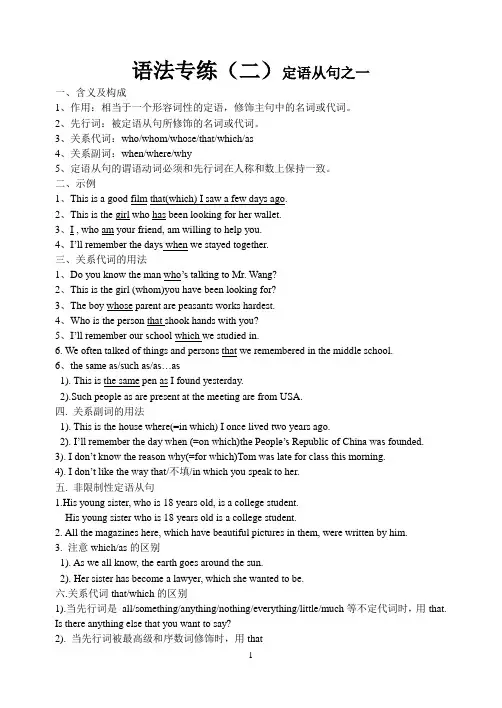
语法专练(二)定语从句之一一、含义及构成1、作用:相当于一个形容词性的定语,修饰主句中的名词或代词。
2、先行词:被定语从句所修饰的名词或代词。
3、关系代词:who/whom/whose/that/which/as4、关系副词:when/where/why5、定语从句的谓语动词必须和先行词在人称和数上保持一致。
二、示例1、This is a good film that(which) I saw a few days ago.2、This is the girl who has been looking for her wallet.3、I , who am your friend, am willing to help you.4、I’ll remember the days when we stayed together.三、关系代词的用法1、Do you know the man who’s talking to Mr. Wang?2、This is the girl (whom)you have been looking for?3、The boy whose parent are peasants works hardest.4、Who is the person that shook hands with you?5、I’ll remember our school which we studied in.6. We often talked of things and persons that we remembered in the middle school.6、the same as/such as/as…as1). This is the same pen as I found yesterday.2).Such people as are present at the meeting are from USA.四. 关系副词的用法1). This is the house where(=in which) I once lived two years ago.2). I’ll remember the day when (=on which)the People’s Republic of China was founded.3). I don’t know the reason why(=for which)Tom was late for class this morning.4). I don’t like the way that/不填/in which you speak to her.五. 非限制性定语从句1.His young sister, who is 18 years old, is a college student.His young sister who is 18 years old is a college student.2. All the magazines here, which have beautiful pictures in them, were written by him.3. 注意which/as的区别1). As we all know, the earth goes around the sun.2). Her sister has become a lawyer, which she wanted to be.六.关系代词that/which的区别1).当先行词是all/something/anything/nothing/everything/little/much等不定代词时,用that. Is there anything else that you want to say?2). 当先行词被最高级和序数词修饰时,用thatThis is the best film that I have seen.3). 当先行词被only/few/little/no修饰时,用thatThis is the only one of the good films that has been seen.4). 当介词提前时,用which而不用that.This is the house in which I once lived.七. 注意事项1. 注意确定先行词Is this factory___ you visited yesterday?A. thatB. whichC. whereD. the one2. 如先行词是those/anyone时,指人,则用whoThose who are working late into the night are teachers.3. 如先行词是point/scene/situation/position/stage时用where.We’re trying to reach a point__ both sides will sit down and talk.4. 如果先行词是occasion/period时,用when.5. 定语从句的谓语动词必须和先行词在人称和数上保持一致。

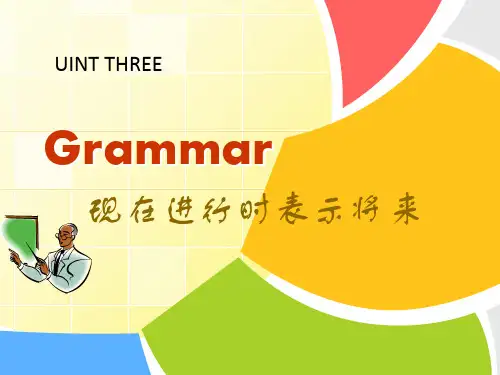
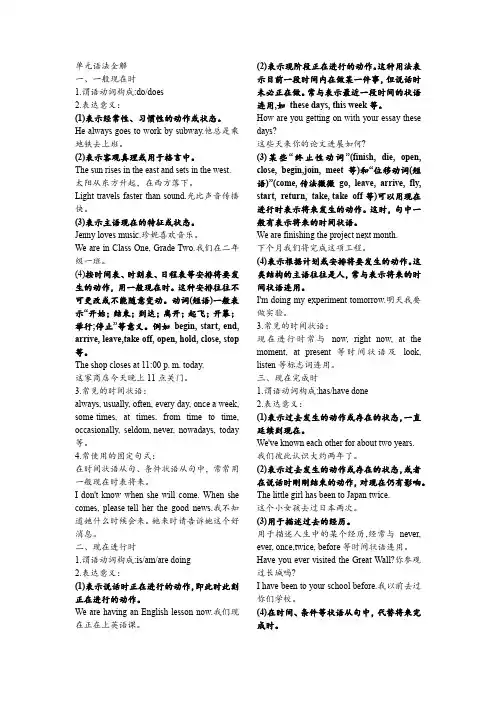
单元语法全解一、一般现在时1.谓语动词构成:do/does2.表达意义:(1)表示经常性、习惯性的动作或状态。
He always goes to work by subway.他总是乘地铁去上班。
(2)表示客观真理或用于格言中。
The sun rises in the east and sets in the west.太阳从东方升起,在西方落下。
Light travels faster than sound.光比声音传播快。
(3)表示主语现在的特征或状态。
Jenny loves music.珍妮喜欢音乐。
We are in Class One, Grade Two.我们在二年级一班。
(4)按时间表、时刻表、日程表等安排将要发生的动作,用一般现在时。
这种安排往往不可更改或不能随意变动。
动词(短语)一般表示“开始;结束;到达;离开;起飞;开幕;举行;停止”等意义。
例如begin, start, end, arrive, leave,take off, open, hold, close, stop 等。
The shop closes at 11:00 p. m. today.这家商店今天晚上11点关门。
3.常见的时间状语:always, usually, often, every day, once a week, some-times, at times, from time to time, occasionally, seldom,never, nowadays, today 等。
4.常使用的固定句式:在时间状语从句、条件状语从句中,常常用一般现在时表将来。
I don't know when she will come. When she comes, please tell her the good news.我不知道她什么时候会来。
她来时请告诉她这个好消息。
二、现在进行时1.谓语动词构成:is/am/are doing2.表达意义:(1)表示说话时正在进行的动作,即此时此刻正在进行的动作。
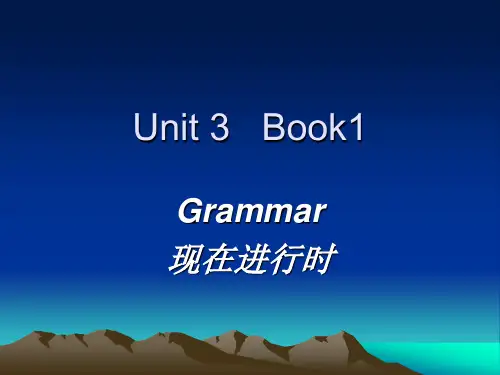
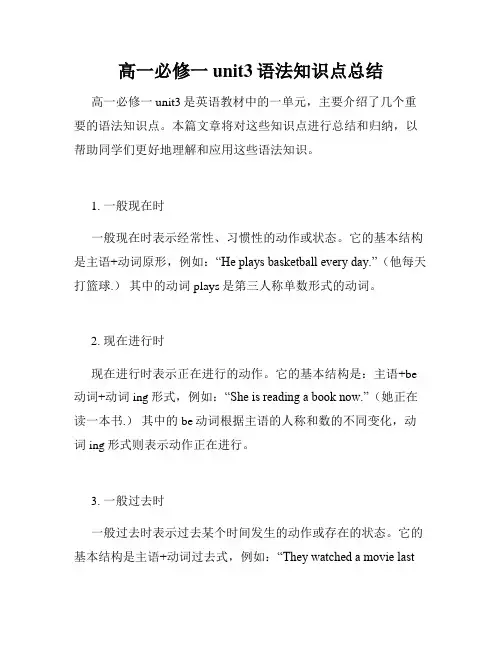
高一必修一unit3语法知识点总结高一必修一unit3是英语教材中的一单元,主要介绍了几个重要的语法知识点。
本篇文章将对这些知识点进行总结和归纳,以帮助同学们更好地理解和应用这些语法知识。
1. 一般现在时一般现在时表示经常性、习惯性的动作或状态。
它的基本结构是主语+动词原形,例如:“He plays basketball every day.”(他每天打篮球.)其中的动词plays是第三人称单数形式的动词。
2. 现在进行时现在进行时表示正在进行的动作。
它的基本结构是:主语+be 动词+动词ing形式,例如:“She is reading a book now.”(她正在读一本书.)其中的be动词根据主语的人称和数的不同变化,动词ing形式则表示动作正在进行。
3. 一般过去时一般过去时表示过去某个时间发生的动作或存在的状态。
它的基本结构是主语+动词过去式,例如:“They watched a movie lastnight.”(他们昨晚看了一场电影.)过去式的构成形式有规则变化和不规则变化,需要根据具体的动词来确定。
4. 过去进行时过去进行时表示过去某个时间正在进行的动作。
它的基本结构是:was/were+动词ing形式,例如:“I was studying when he called me.”(他给我打电话的时候,我正在学习.)过去进行时的be动词形式根据主语的人称和数的不同变化,动词ing形式则表示过去进行的动作。
5. 一般将来时一般将来时表示将要发生的动作或存在的状态。
它的基本结构是:will/shall+动词原形,例如:“I will go to Beijing next week.”(我下周将去北京.)不同的人称和数有不同的构成形式。
6. 现在完成时现在完成时表示过去某个时间开始的动作一直延续到现在,或者过去发生的动作对现在产生的影响。
它的基本结构是:have/has+动词过去分词,例如:“I have lived here for ten years.”(我住在这里已经十年了.) have/has的形式根据主语的人称和数的不同变化,动词过去分词则表示动作已经完成。
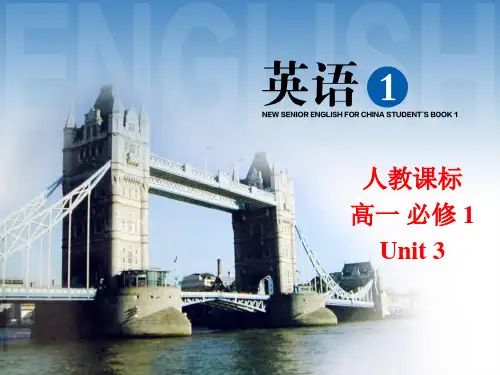
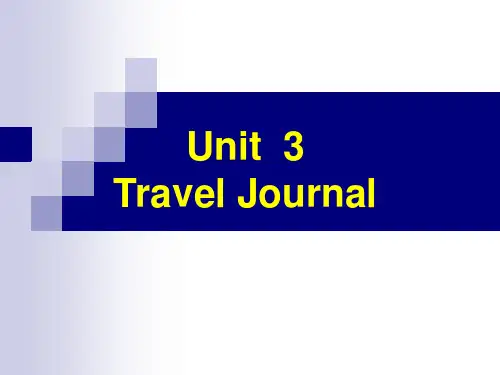
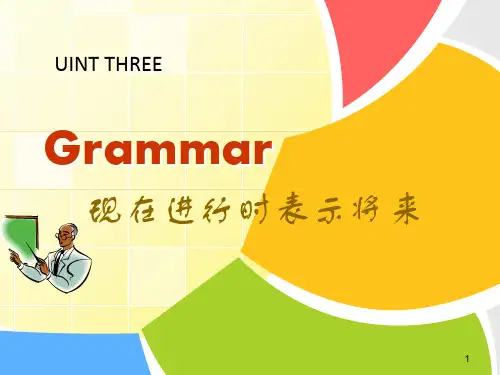
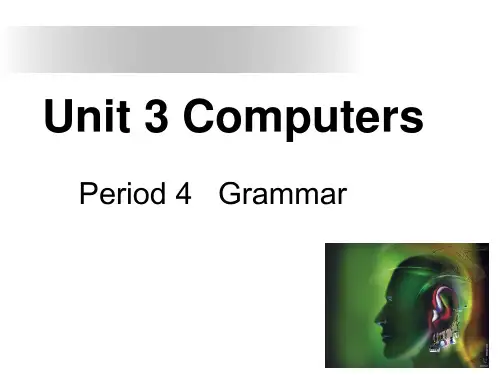
语法:反意疑问句一、基本用法与结构反意疑问句由“陈述句+简略疑问句”两部分组成,第一部分提出一种看法,第二部分用来质疑或表示证实。
陈述部分与疑问部分的动词时态和动词性质应保持一致,而且肯定和否定形式彼此相反,即陈述部分为肯定式时,疑问部分用否定式,陈述部分为否定式时,疑问部分用肯定式:He likes English, doesn’t he? 他喜欢英语,是吗?He doesn’t like English, does he? 他不喜欢英语,是吗?【注】1. 若陈述部分含有seldom, hardly, never, few, nothing等否定词或半否定词,其疑问部分要用肯式:He has few friends here, has he? 他在这儿几乎没什么朋友,是吗?She said nothing, did she? 她什么也没说,是不是?2. 若陈述部分含有带否定前缀的词,疑问部分仍用否定式:It is unfair, isn’t it? 这不公平,不是吗?It is impossible, isn’t it? 那是不可能的,是吗?二、反意疑问句的主语问题1. 基本原则:疑问部分的主语应与陈述部分主语一致,且只能是代词:Mary is a nurse, isn’t she? 玛丽是护士,对吗?2. 当陈述部分为there be句型时,疑问部分仍用there作“主语”:There was nothing in the room, was there? 房间里什么也没有,是吗?3. 当陈述部分的主语是指示代词时,疑问部分用it, they等代词:That is a new car, isn’t it? 这是一辆新汽车,是吗?4. 当陈述部分的主语是复合不定代词时,若陈述部分的主语为somebody, someone, everyone, everybody, no one, nobody等复合不定代词,其反意疑问句的主语在正式文体中用he,在口语或非正式文体中通常用they:Nobody was late, were they? 没有一个人迟到,是吗?5.当陈述部分的主语是something, anything, nothing, everything等复合不定代词时,其反意疑问句的主语要用it:Everything is ready, isn’t it? 一切都准备好了吗?Nothing is important, is it? 没有什么重要的,不是吗?三、陈述部分有动词have的反意疑问句1. 当have 为助动词时,其反意疑问句沿用同样的助动词:He has already left, hasn’t he? 他已经离开了,是吗?2. 当have 为实意动词时,要分两种情况:① 若表示“所有”,反意疑问句可以用have,也可以用do:He has a lot of friends here, hasn’t [doesn’t] he? 他在这儿有许多朋友,是吗?但是若陈述部分用的是have的否定式,反意疑问句用have 还是用do,取决于陈述部分的动词形式:He hasn’t any money, has he? 他没有钱,是吗?He doesn’t have any money, does he? 他没有钱,是吗?① 若表示“吃”、“玩”等意思,反意疑问句要用do:He has supper at 5, doesn’t he? 他5点吃晚餐,是吗?He had a good time at the party, didn’t he? 他在晚会上玩得很开心,是吗?3. 当用于have to时,通常也有两种可能:若表示经常性的行为,则多用加助动词do的形式;若表示特定的行为,则多用have:He often has to get up early, doesn’t he? 他经常要早起,是吗?He has to go to bed late tonight, hasn’t he? 他今晚要迟睡,是吗?四、含情态动词的反意疑问句1. 基本原则:在通常情况下,当陈述部分含有情态动词时,疑问部分会重复前面同样的情态动词:He can speak English, can’t he?他会说英语,是吗?We shouldn’t go, should we? 我们不应该去,对不对?2. 当陈述部分含有must时,要分两种情况:① 若must表示“必须”或“有必要”,疑问部分用mustn’t 或needn’t:You must leave at once, mustn’t [needn’t] you? 你必须(有必要)马上离开,是吗?但是若陈述部分有mustn’t表示禁止,疑问部分要must:You mustn’t laugh, must you? 你不准笑,知道吗?① 若must表示推测,疑问部分不能用must,而应根据must后的动词结构采用相应的动词形式:He must be tired, isn’t he? 他一定累了,是吗?五、陈述部分为祈使句的反意疑问句1. 基本原则:若陈述部分为祈使句,疑问部分通常用will you:Please help us, will you? 请帮帮我们,好吗?Come with us, will you? 同我们一起去,好吗?Don’t forget to post the letter, will you? 请别忘了寄信。
Module 1 Unit 3 Travel Journal1. Think about the fare for different kinds of transport and decide how to get there.疑问词+ to do 做宾语I don’t know how to do. XI don’t know how to do it.Fare 交通费用Tip 小费A fat/ thin tipTuition 学费Fine 罚款FeeMiscellaneous fees 杂费Scholarship 奖学金Bonus 奖金2. They are Dai and grew up in western Yunnan Province near the Lancang River, the Chinese part of the river that is called the Mekong River in other countries.The Dai people先行词+,+同位语+定语从句He writes with his left hand, the one others seldom use.Meeting my uncle after so many years is an unforgettable moment, one I will remember for ever.Table manners are a quite important matter, one that will be likely to destroy your image.3. She gave me a determined look -- the kind that said she wouldn’t change her mind.Look 神情Say 表示书信报刊通知等有何内容。
Unit3 单元语法详解现在进行时表将来现在进行时主要表示现在或目前正在进行的动作。
然而在特殊情况下,现在进行时还可表示将来,主要用于表示按计划或安排要发生的动作,翻译为“打算……”、“将要……”。
通常会有表示将来的时间状语如tomorrow、next week等,但有明确的上下文的时候不需要指出时间。
能用于现在进行时表将来的动词常见的有:go、come、leave、start等。
一、表示将来的动作,多指已计划好的事I'm leaving for Beijing tomorrow.我明天去北京。
I'm going.我要走了。
I'm coming.我要来了。
When are you starting?你什么时候动身?She is buying a new bike soon.她不久将买一辆新自行车。
We are flying to Shanghai next Friday.下周五我们乘飞机去上海。
例1 She (leave) tomorrow and you had better see her off.解析:本句考查时态,由时间状语tomorrow可知用现在进行时表将来。
答案:is leaving二、现在进行时也可在时间状语从句、条件状语从句中表示将来When you are passing by my front door,please drop in on me.当你从我家门前经过,请顺便来看看我。
注意:现在进行时的其他用法:1.表示现在或近期正在进行的情况。
I am writing a letter now.我现在正在写信。
Mr Green is writing another novel these days.格林先生这些天正在写另一部小说。
例2 Listen!The couple(quarrel)in the next room.解析:由语境及“Listen!”可知应用现在进行时。
人教版高一英语必修一第三单元知识点人教版高一英语必修一第三单元知识点以下是给你推荐的高一英语必修一第三单元知识点,希望对你有帮助!英语必修一第三单元知识点一、语法The Present Continuous Tense for Future Actions1.现在进行时表示一般现在时现在进行时有时用来代替一般现在时,表示一个经常性动作或状态,为了表示一种情感:eg: He is always helping others.(表示赞许的情感)She is always lying to me.(表示不满的情感)或是为了强调情况的暂时性。
eg: I'm walking to school because my bike is broken.For these three days, we are starting at 8:00.2.现在进行时可用来表示将来时, 现在进行时表示将来时,即表示按计划或安排在最近将要进行的动作。
特别是一些表示“移动性的动词,如:go, come, arrive, leave, start, fly, get等,常用进行时表示将来时。
如:My mother is leaving for Canada tomorrow.How long are you staying in Guangzhou?二、高频考点 1.consider doing sth.=think of doing sth.“考虑做某事,如:I'm considering going abroad for further study.consider carefully before taking action 三思而后行consider ... (as), regard ... as ..., treat ... as ...都含“认为……是……意思。
consider侧重“经过考虑而认为,表示“一种比较客观的看法, 如:consider what he said (as) reasonable. 我认为他说的有道理。